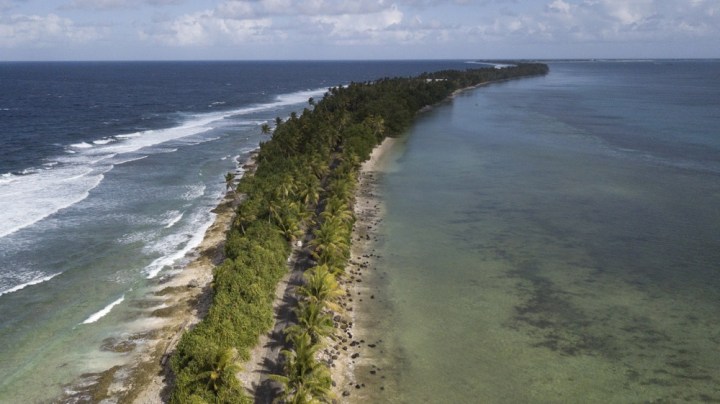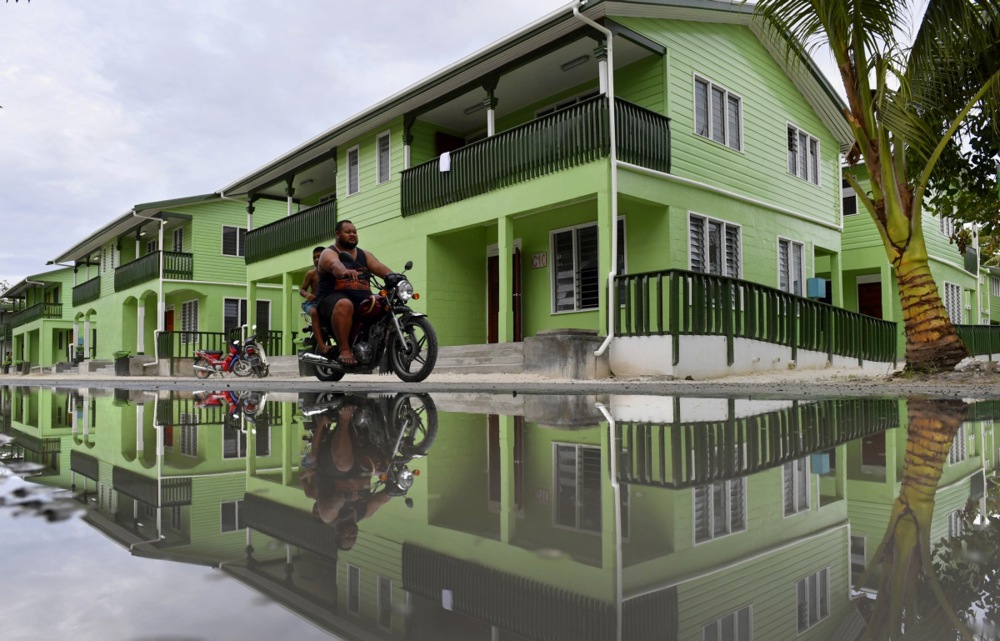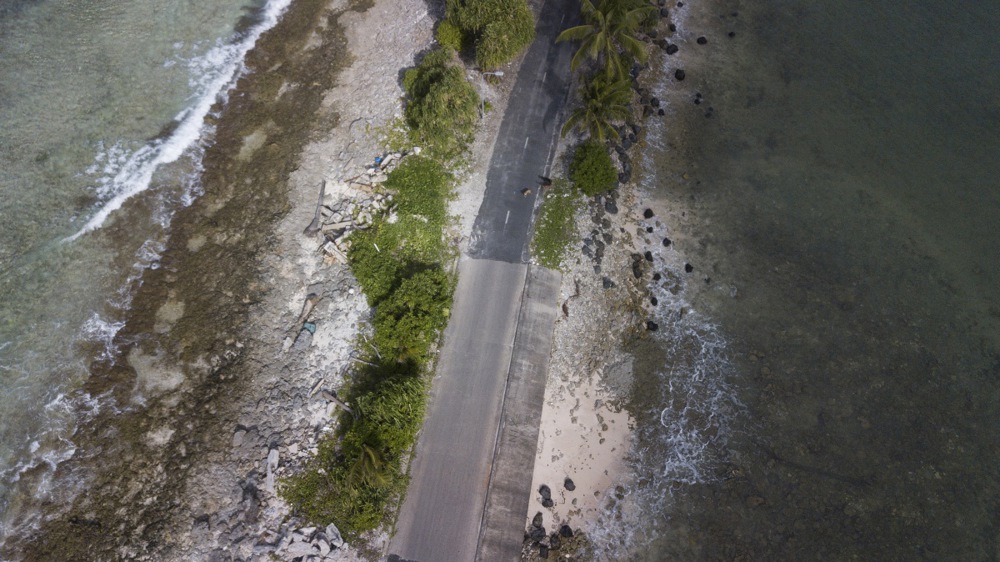LIVE SMARTER
Island nation of Tuvalu adopting AI and VR to adapt to growing rising seas threat

Island nations are the first to get hit by rising seas. To fight the climate crisis, Tuvalu has turned to new Artificial Intelligence and Virtual Reality technologies in an attempt to save itself.
Some people don’t have the luxury of self-delusion. When you have seen the effects of climate change batter your home within your lifetime, you might be afforded a more appropriately panicked perspective on the existential crisis which we’re all quietly slipping into.
Tuvalu is a low-lying archipelago of nine small islands in the South Pacific Ocean. With about 11,000 people, it’s the fourth smallest nation in the world, and the average elevation of the country is a mere 1.83 meters, just half a meter above high tide.
Climate change threatens Tuvalu on two fronts: the destabilising of the global climate exacerbates increasingly destructive cyclones which batter their coast, and rising seas are swallowing the country bit by bit. In 2020, Cyclone Pam displaced 45% of the population, and even optimistic estimations of rising seas predict that by 2050, half of the capital of Tuvalu will be flooded by daily tidal waters. By the end of this century, 95% of it will likely be submerged during routine high tides.
The only thing that would preserve South Pacific island countries in the long term would be a great enough global shift in culture and government policy to stop climate change. The Prime Ministers of Fiji, Saint Vincent and the Grenadines, Antigua and Barbuda, Samoa, etc have strongly advocated for climate reform, but given the global economy’s current dependency on growth, they have been forced to come up with a variety of short-term solutions instead.
Fijian villages are being relocated to higher ground, the Maldives are investing in floating cities, and the Marshall Islands are considering attempting to raise the island itself by dredging and burying material from the ocean floor around it. Tuvalu’s response seems to have been the most sophisticated, taking advantage of the predictive power of artificial intelligence, and given its emerging success, other countries may follow suit.

A man rides a motorbike through a puddle of water in Funafuti, Tuvalu, on 13 August 2019 (issued 15 August 2019). (Photo: EPA-EFE/Mick Tsikas)
The Coastal Adaptation Project
Tuvalu has taken on a 38.9 million dollar project called TCAP to increase the resilience of its vulnerable communities against wave-induced damages. Over the last few decades, the country has attempted to install conventional seawall protection measures, but they’ve often proved costly and ineffective, and tend to be washed away as soon as a cyclone hits; they can even cause increased coastal erosion in the areas nearby, moving the problem rather than solving it.
One of the main challenges to developing effective coastal solutions for a country like Tuvalu is obtaining reliable biophysical data so that the measures taken can be suited to the unique environment, so Tuvalu has been mapping the contours, tides and wave activity around its coast and feeding that data to AI programs that model the most efficient barriers to prevent erosion.
The project utilised Light Detection and Ranging (Lidar) sensors mounted on aircraft to survey the coast, precisely mapping the height and depth of more than 500 km2 of land and seafloor. Engineers input that data into AI-based software that generated predictive models of how different barrier designs would affect sea level and wave activity.
Using these models, TCAP has settled on three barrier plans to reclaim coastal territory, which they estimate will create 2780 square meters of new coastal land around three islands, and may protect communities on those islands from the severe effects of storm surges for a century.
The project has generated short-term jobs in construction and medium-term jobs in the monitoring and maintenance of the project. TCAP has focused especially on creating employment for women and young people, who are being trained to international standards.
Once construction is completed, the damaged territory will be rehabilitated and some of the new land reclaimed by the barriers will be revegetated in order to stabilise the barriers and provide habitat for wildlife. The revegetation efforts will also require contracted labour.

An aerial view of the of the island north of Funafuti, Tuvalu, on 15 August, 2019. (Photo: EPA-EFE/Mick Tsikas)
The barriers
The largest construction will protect Funafuti island, where most of the country’s economic and political assets are situated. A 780-meter-long, 100-meter-wide “bunded reclamation” barrier will be constructed from roughly 250,000 cubic metres of sand dredged from Fongafale Lagoon. Once the project is completed in 2024, the bund will be the highest land on the island — about two and a half meters above the highest astronomical tide. The plans also include a small boat harbour on the eastern end of the barrier that should provide safe all-tide access to local vessels and act as a major stormwater channel from the adjacent village during the monsoon season.
Animation of #TCAP proposal to create 700m long, 100m wide elevated area of land along Vaiaku waterfront on Funafuti🇹🇻.The reclaimed area will rise up to 3.5m above sea level to provide protection from inundation from cyclones & sea level rise. Stay tuned! https://t.co/hFAp2E2a16 pic.twitter.com/0nMiwPHvrb
— The Tuvalu Coastal Adaptation Project 🏝️ (@TCAP4Tuvalu) December 10, 2020
Nanumea, the country’s northernmost atoll, will be protected by several barriers: a 1330-metre Berm Top Barrier on its western coast, seven 25-metre long precast concrete Reef Top Barriers on its northern reef, as well as a 170-metre long concrete “Seabee” seawall to replace a revetment barrier that failed during Cyclone Pam.
The last project should protect Nanumaga with a 665-metre Berm Top Barrier on its western coast made of 20-metre long Geotextile Mega Containers that will be covered with locally-sourced earth and revegetated to minimise risk of wave damage during cyclone season. The existing concrete boat ramp on the coast will be raised and extended over the berm to reach the village centre.
The @UNDP_Pacific final detail design for Nanumaga 🏝️ in 🇹🇻 will address the vulnerability of people to storm surge on the tiny 🏝️ of 🇹🇻. @theGCF is supporting #Climate #Resilience for USD$36m for the 3 island in 🇹🇻. The leaders of Nanumaga shows appreciation for the kind support pic.twitter.com/rqwHM6Y5Iz
— The Tuvalu Coastal Adaptation Project 🏝️ (@TCAP4Tuvalu) July 13, 2021
Tuvalu says it’s moving to the Metaverse
As exciting as the Coastal Adaptation Project is, it’s not a long-term solution. The project aims to protect the country for 80 years, by which time, they would need more measures in place. So Tuvalu claim to be implementing another project to preserve their future in the worst-case scenario, to “move the entire country to the metaverse”.
Tuvalu’s foreign minister, Simon Kofe, addressed COP27 last year from a virtual version of a Tuvaluan island, saying “Islands like this one won’t survive rapid temperature increases, rising sea levels and drought, so we’ll recreate them virtually. As our land disappears we have no choice but to become the world’s first digital nation.”
The metaverse is the name we have given to a possible iteration of our future in which augmented and virtual reality interfaces are integrated into our everyday life.
This digitised world has been conceived in a variety of ways, most publicly by Meta (Zuckerberg’s umbrella company that was formerly Facebook).
Kofe announced at COP27 that Tuvalu’s contingency plan is to create a digital twin of itself in the cloud. The idea is that in the event of significant loss of inhabitable territory due to submergence, Tuvalu could function fully as a sovereign state entirely from cyberspace, even after its people have been relocated elsewhere.
Mapping the archipelago digitally would preserve the memory of the country’s natural beauty in an interactive space and provide a platform where Tuvaluans could interact regularly and hopefully retain a sense of cultural nationhood. Most practically, it would safeguard Tuvaluans’ rights from a diplomatic standpoint.
Tuvalu’s plan is not entirely unprecedented — the technology to render an immersive simulation of real spaces is already widely used on platforms like VRChat, and evolving rapidly; and there are prior, less extensive examples of governments using online platforms to carry out location-based functions.
Sweden has set up a functional online embassy in a virtual reality platform called Second Life. Estonia has been providing access to services like company registration or banking for non-Estonians since 2014 through their e-residency program. Liberland is a Balkan micronation that has sort of existed on a 7-square km sliver of land between Serbia and Croatia since 2015. They only announced the establishment of their first, tiny in-person settlement on 4 August 2023, but their online citizenry applicants number over 700,000. These citizens won’t be setting up shop in the tiny chunk of Balkan land, they’re waiting for their home to finish being built online.
But there are practical hurdles to the notion of a nation in the metaverse: participants would need extremely high Wifi bandwidth which is not yet possible, and a widely utilised metaverse would require physical infrastructure — servers, enormous data centres, digital interfaces, headsets etc. The production and continual use of this technology consumes a lot of energy and produce carbon emissions too.
While Tuvalu’s exodus to the metaverse is a prime example of technological solutionism, and might be more effective as a publicity stunt than an actual plan of action, even the Coastal Adaptation Project is adapting to the problem at hand rather than solving it. Many nations could learn from TCAP’s ingenuity, efficiency and ethical standards, but Tuvalu’s barriers are not going to stop the seas from rising — only the slowing of climate change via the reduction of global carbon emissions can do that. DM
To read all about Daily Maverick’s recent The Gathering: Earth Edition, click here.


















 Become an Insider
Become an Insider
Oh what nonsense! If yo believed what these con artists have been peddling, the Maldives and many other island nations would have been underwater already